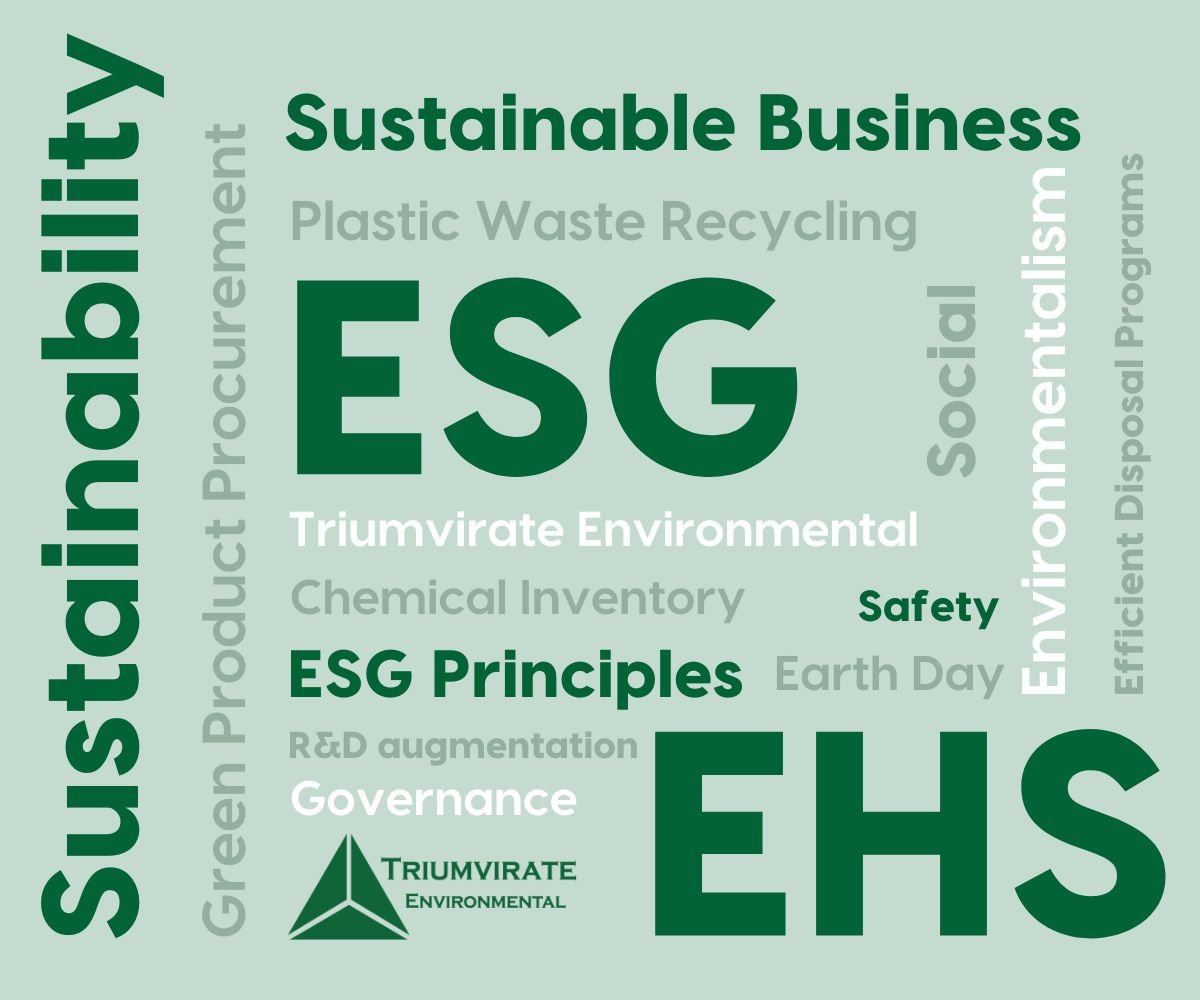The Increasing Impact of Sustainability (and ESG) in the EHS Field
Reflecting on Earth Month, the prominence of celebrations worldwide reinforces that the global commitment to sustainability is as strong as ever. Another harbinger of the growing power of eco-friendliness is the spreading influence of sustainability and environmental, social, and governance (ESG) within the environmental, health, and safety (EHS) field.
It can sometimes feel like the sustainability movement came out of nowhere. In just a few years, what previously didn’t merit a second thought is now intensely scrutinized—and driving demand from the federal government and consumers alike.
Connected with the rise in sustainability consciousness is the growing adoption of ESG principles in the corporate world. ESG is a blanket term to describe a company’s commitment to environmentalism—both financially and within its core operations and principles. ESG carries the idea of sustainability past just the immediate environmental impacts involved in day-to-day business cycles. It seeks to connect long-term operations to what customers, employees, suppliers, and the public want from the business community. ESG is already dictating the requirements for successful operations—for publicly traded and private firms alike.
In today’s world, sustainability and ESG play twin roles throughout the EHS field. Here, we will analyze these roles and how they have changed over time—and provide suggestions for how you can embrace and implement both concepts into your operations so you don’t fall behind.
Environmentalism Throughout History
Sustainability is a relatively recent concept. While concern for environmental destruction dates back to around 500 B.C., the sustainability movement didn’t ramp up until April 22, 1970, the first Earth Day. A number of hazardous environmental events and the subsequent response of outspoken activists led to the first widespread use of the word “sustainability” in regards to environmentalism. This word, in the environmental movement, describes a vital concept: that humans must treat the earth as a finite resource, and protect it at all costs, in order to preserve it for future humans.
The sustainability movement, and its ties to environmentalism, rapidly gained strength. By the late 1980s, sustainability had become a selling point for corporations hoping to appeal to the public’s environmental conscience.
The concept of ESG became prominent later, in 2006, as a way to solidify an organization’s commitment to sustainability. ESG principles provide a platform to ensure that businesses are “putting their money where their mouth is” in terms of environmental commitments and investments. Since the first introduction of the term, ESG has become a global phenomenon, forcing managers to act on sustainability plans with a sense of duty to the Earth and its inhabitants.
Some business managers, concerned about ESG’s impact on their bottom line, failed to adapt. These same managers quickly realized that skimping on ESG in their operations ultimately hurt their market position.
ESG: Why Should I Care?
Everyone in the EHS industry should care about ESG—but not just because it’s the “right thing to do.” Adoption of EHS principles demonstrably helps organizational growth and improves the bottom line of businesses that prioritize it. In fact, a survey of financial institutions by Business Wire revealed that 68% of respondents that implemented ESG criteria into their operations improved their investment returns.
Part of this is because customers want to see ESG prioritized in business. A recent report found that 83% of consumers prioritize companies that lead the way for ESG best practices. This means that companies can make wide ESG goals without compromising their bottom line—the market is rewarding those organizations that support environmental initiatives, such as net zero and carbon neutrality goals, in their capital spending and investment plans.
As an operations or facilities manager, your company’s sustainability goals should constantly be top of mind. Adherence to ESG principles can help prioritize these objectives and support your mission to positively impact employees and the environment.
At the end of the day, the more environmentally friendly a company can be, the more it can grow and successfully acquire increased investment, support, and global goodwill. Viewing it this way justifies the considerable time and effort required to implement ESG initiatives throughout your organization.
ESG Within EHS, Across Industries
In the healthcare, higher education, industrial, and life sciences fields, from the EHS point of view, ESG comes down to sustainability. It enforces your organization’s commitment to protecting the planet—for your consumers, workers, and community. It also means your financial plan accommodates environmentalism, seeking cost-effective ways to use eco-friendly concepts to shape your overall operations.
EHS principles were originally implemented as a way to ensure regulatory compliance. In recent years, however, EHS has blossomed into so much more. And with the expansion of ESG principles into more and more industries, EHS has followed along. Practitioners of ESG are turning the EHS profession into one that recognizes there is more to the field than just compliance.
It has awakened EHS to the general large-scale sustainability and related governance concepts that affect the world overall. Those professionals who promote ESG in their organizations will boost their environmental and safety posture. EHS professionals who ignore ESG adoption will fall behind their peers—and will be potentially compromising operational safety, public image, planetary health, and more.
ESG For Your Operations
As an EHS professional, the first step to committing to ESG implementation is to think about the changes that can—or cannot—be made to your operations, both upstream and downstream. Because ESG is proving itself important, it is vital to know how to implement it within your operations without sacrificing efficiency.
Implementing ESG begins primarily on site, where you can analyze financial scenarios and evaluate risk versus reward outcomes of each concept while simultaneously factoring in ways to increase overall operational sustainability. You can use this methodology when evaluating the products your lab uses, for example. You may be tempted to use an instrument that offers some cost savings over a more expensive, potentially more “sustainable” one—but, hypothetically, the cheaper product may be less safe than the costlier one, or the less expensive instrument may not offer the same advanced capacities. The product choice in this case could greatly harm innovation and set you back on your operational goals. You must weigh the various factors and decide which choices ultimately best support your sustainability and ESG goals while still supporting your operations.
The key to ongoing ESG success is to constantly analyze safety and efficiency risks—which is a core pillar of the EHS industry already—while considering the ways that sustainability initiatives will impact your bottom line.
6 Focus Areas for ESG Principles
When implementing ESG principles at your facility, you should consider at a minimum:
-
Plastic waste recycling:
Efficient plastics recycling programs save money and reduce pollution—keeping your plastics from the landfill results in less potential chemical contamination and lower greenhouse gas emissions. When operating in large volumes, such a program may also cut your transportation and related costs. Start—or boost—your program by targeting office, kitchen, lab, manufacturing, or other plastics, contaminated or not, for recycling. -
Green product procurement:
Evaluate all products used in your facility, from lab equipment to chemicals, operations supplies, waste containers, and more. As much as possible, seek the most sustainable products—and have a plan in place for waste disposal before the products are procured. Not only will this help prevent virgin materials in your operations, but it will also make disposal easier if you have a plan and system in place for waste before it is even generated. Proper upstream waste management can ensure each specific waste ends up in the right disposal stream and proper disposal. -
Efficient disposal programs:
You should also evaluate the end-life of products downstream—and dispose of all waste in as sustainable a way as possible. This approach can prevent you from paying penalties for the improper disposal of different waste streams. For both downstream waste disposal and upstream product selection, the challenge is to find those items that produce minimal waste and require the least energy—while simultaneously supporting R&D or production outcomes. -
Chemical inventory management:
Knowing what chemicals you have at all times, in what quantities, has many advantages. One such benefit is that it informs response in the case of a chemical event. Prompt and informed event response will help protect the environment from harm and keep the community safe. Robust chemical inventory management also allows you to analyze your operations in depth to determine if more sustainable options are available. You can evaluate your existing chemical inventory, identify the most toxic of them, and determine if there are safer or more sustainable alternatives you can swap in without sacrificing operational efficiency. Finally, chemical inventory management will make procurement more efficient, reducing costs and avoiding excess buildup of chemical stocks. This will prevent over-ordering of chemicals that you already have and reduce waste generation of old, potentially expired or volatile chemicals. -
Sustainable improvement partnerships
: Many organizations support environmental program implementation and can help you achieve your sustainability goals. One of these such organizations, My Green Lab, promotes environmental sustainability in lab spaces. This organization, among others, can help you to meet ESG goals and realize long-term savings—improving your bottom line. -
R&D augmentation:
Managers and existing EHS teams often find themselves overburdened when ensuring routine obligations are met, leaving little time for R&D. Partnering with a full- or part-time partner team can help take this added stress off of your teams—ensuring you get EHS and ESG right and maintain consistent improvement at your facility while you focus on core competencies.
As a leader in the EHS space, Triumvirate Environmental is committed to ensuring your ESG success. We, like you, are working through ESG considerations—together, we can work toward a healthier planet. Interested in learning more? Contact Triumvirate Environmental today.






